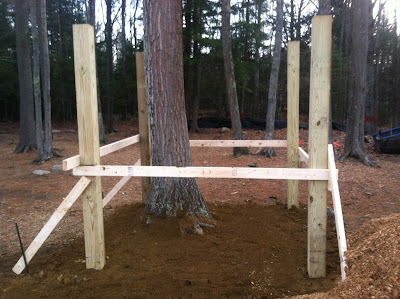Of all the projects so far, this one was the most fraught with delay--but it's finally here! Part of the difficulty was that we were making the fort from scratch and it had to conform to strict playground building codes. The entire structure was designed and built by our very own Woodside parent, Rick Schultz. This homemade fort saved us thousands of dollars compared to an out-of-the-box piece of equipment and the workmanship can't be beat. It's going to last a very long time.
Thanks to a mild fall and early winter, we were able to dig the holes for the posts with little trouble. Temporary boards were put in place to help us square up the posts, then we back-filled the holes. We chose to build around a tree at the edge of the woods but near the slide, which seemed to follow the natural flow of play.
Rick chose white cedar for the project, which will not only last a long time but also has a fantastic smell. Over the course of several weeks, he built the frame at his home in a modular fashion so that on-site assembly would be quick. And it was! The pieces fit together perfectly, like a jigsaw puzzle.
Here are the two halves of the platform arriving on a trailer.
The platform pieces were carefully laid on top of the posts and support beams.
Then they were joined together.
The end pieces were put in place.
Then the sides. Have you noticed the interesting shape? Instead of the usual rectangle you'll find on most tree forts, this one echoes the shape of a boat. The plywood was only on the sides as a temporary measure for support and safety until the rope panels were put in place.
Mr. Dedek was on hand for the build, helping us rake the enormous pile of wood chips beneath the structure.
Next came the stairs, which were required instead of a conventional ladder. Although we don't have one now, at some point in the future we'd like to add a ramp on the back of the structure.
Rick Schultz made these beautiful handrails by routing a few boards. They have been sanded to a smooth finish. No splinters here!
After the plywood was removed, the rope panels were inserted. Commercial fishing rope was threaded through eye-bolts and hand-tied by playground volunteers. This was a very cost-effective way to create small enough openings to pass code. The rope panels also allow for visibility and fit in well with our boat theme.
The final step was to lay down the decking and the top rails.
Here's the finished masterpiece! A huge thank-you to Rick Schultz for the countless hours of work and care he put into this project and to all the volunteers who worked many hours in the cold. The kids are going to love it!
















No comments:
Post a Comment
Note: Only a member of this blog may post a comment.